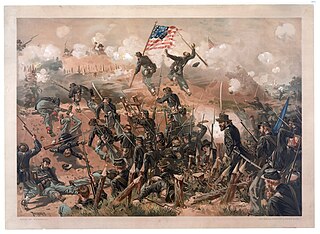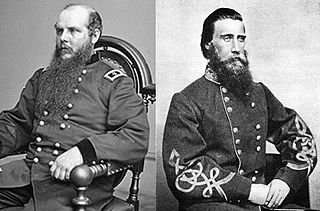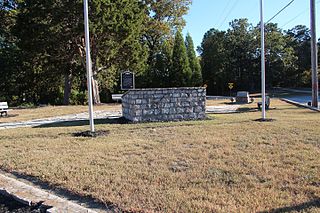
The siege of Vicksburg was the final major military action in the Vicksburg campaign of the American Civil War. In a series of maneuvers, Union Major General Ulysses S. Grant and his Army of the Tennessee crossed the Mississippi River and drove the Confederate Army of Mississippi, led by Lieutenant General John C. Pemberton, into the defensive lines surrounding the fortress city of Vicksburg, Mississippi, leading to the successful siege and Confederate surrender.

The Battle of Nashville was a two-day battle in the Franklin-Nashville Campaign that represented the end of large-scale fighting west of the coastal states in the American Civil War. It was fought at Nashville, Tennessee, on December 15–16, 1864, between the Confederate Army of Tennessee under Lieutenant General John Bell Hood and the Union Army of the Cumberland (AoC) under Major General George H. Thomas. In one of the largest victories achieved by the Union Army during the war, Thomas attacked and routed Hood's army, largely destroying it as an effective fighting force.

The Atlanta campaign was a series of battles fought in the Western Theater of the American Civil War throughout northwest Georgia and the area around Atlanta during the summer of 1864. Union Maj. Gen. William Tecumseh Sherman invaded Georgia from the vicinity of Chattanooga, Tennessee, beginning in May 1864, opposed by the Confederate general Joseph E. Johnston.

The Battle of Missionary Ridge, also known as the Battle of Chattanooga, was fought on November 25, 1863, as part of the Chattanooga campaign of the American Civil War. Following the Union victory in the Battle of Lookout Mountain on November 24, Union forces in the Military Division of the Mississippi under Maj. Gen. Ulysses S. Grant assaulted Missionary Ridge and defeated the Confederate Army of Tennessee, commanded by Gen. Braxton Bragg, forcing it to retreat to Georgia.

The Battle of Kennesaw Mountain was fought on June 27, 1864, during the Atlanta Campaign of the American Civil War. The most significant frontal assault launched by Union Major General William T. Sherman against the Confederate Army of Tennessee under General Joseph E. Johnston, it produced a tactical defeat for the Union forces but failed to deliver the result that the Confederacy desperately needed: a halt to Sherman's advance on Atlanta, Georgia.

The Battle of Columbia was a series of military actions that took place November 24–29, 1864, in Maury County, Tennessee, as part of the Franklin-Nashville Campaign of the American Civil War. It concluded the movement of Lt. Gen. John Bell Hood's Confederate Army of Tennessee from the Tennessee River in northern Alabama to Columbia, Tennessee, and across the Duck River. A Union force under Maj. Gen. John M. Schofield skirmished with Hood's cavalry, commanded by Maj. Gen. Nathan Bedford Forrest, and fortified a defensive line south of Columbia, but soon withdrew north across the Duck River, abandoning the town. Hood's invasion of Tennessee continued as he attempted to intercept Schofield's retreating army at Spring Hill.
The Third Battle of Murfreesboro, also known as Wilkinson Pike or the Cedars, was fought December 5–7, 1864, in Rutherford County, Tennessee, as part of the Franklin-Nashville Campaign of the American Civil War.

The Battle of Spring Hill was fought November 29, 1864, at Spring Hill, Tennessee, as part of the Franklin-Nashville Campaign of the American Civil War. The Confederate Army of Tennessee, commanded by Lt. Gen. John Bell Hood, attacked a Union force under Maj. Gen. John M. Schofield as it retreated from Columbia through Spring Hill. Because of a series of command failures, the Confederates were unable to inflict serious damage on the Federals and could not prevent their safe passage north to Franklin during the night. The next day, Hood pursued Schofield and attacked his fortifications in the Battle of Franklin, resulting in severe Confederate casualties.

The XVI Army Corps was a corps of the Union Army during the American Civil War. The corps rarely fought as a single unit, as its divisions were often scattered across the country.

The Battle of Jonesborough was fought between Union Army forces led by William Tecumseh Sherman and Confederate forces under William J. Hardee during the Atlanta Campaign in the American Civil War. On the first day, on orders from Army of Tennessee commander John Bell Hood, Hardee's troops attacked the Federals and were repulsed with heavy losses. That evening, Hood ordered Hardee to send half his troops back to Atlanta. On the second day, five Union corps converged on Jonesborough. For the only time during the Atlanta Campaign, a major Federal frontal assault succeeded in breaching the Confederate defenses. The attack took 900 prisoners, but the defenders were able to halt the breakthrough and improvise new defenses. Despite facing overwhelming odds, Hardee's corps escaped undetected to the south that evening.

The Franklin–Nashville campaign, also known as Hood's Tennessee campaign, was a series of battles in the Western Theater, conducted from September 18 to December 27, 1864, in Alabama, Tennessee, and northwestern Georgia during the American Civil War.

Romeyn Beck Ayres was a Union Army general in the American Civil War.

The Battle of Dallas was an engagement during the Atlanta Campaign in the American Civil War. The Union army of William Tecumseh Sherman and the Confederate army led by Joseph E. Johnston fought a series of battles between May 25 and June 3 along a front stretching northeast from Dallas toward Acworth, Georgia. At Dallas a probe launched by William B. Bate's and William Hicks Jackson's Confederate divisions accidentally turned into a full-scale assault against the defenses of John A. Logan's XV Corps. The attack was driven off with heavy Confederate losses. The previous Union defeats at New Hope Church and the Pickett's Mill are sometimes considered with Dallas as part of one battle.

The western theater of the American Civil War encompassed major military operations in the states of Alabama, Georgia, Florida, Mississippi, North Carolina, Kentucky, South Carolina and Tennessee, as well as Louisiana east of the Mississippi River. Operations on the coasts of these states, except for Mobile Bay, are considered part of the Lower Seaboard Theater. Most other operations east of the Appalachian Mountains are part of the eastern theater. Operations west of the Mississippi River took place in the trans-Mississippi theater.

The Battle of New Hope Church was a clash between the Union Army under Major General William T. Sherman and the Confederate Army of Tennessee led by General Joseph E. Johnston during the Atlanta Campaign of the American Civil War. Sherman broke loose from his railroad supply line in a large-scale sweep in an attempt to force Johnston's army to retreat from its strong position south of the Etowah River. Sherman hoped that he had outmaneuvered his opponent, but Johnston rapidly shifted his army to the southwest. When the Union XX Corps under Major General Joseph Hooker tried to force its way through the Confederate lines at New Hope Church, its soldiers were stopped with heavy losses.

The Battle of Pickett's Mill was fought in Paulding County, Georgia, between Union forces under Major General William Tecumseh Sherman and Confederate forces led by General Joseph E. Johnston during the Atlanta Campaign in the American Civil War. Sherman sent Brigadier General Thomas J. Wood's division, supported by other formations, to turn Johnston's right flank, but the Federals were repulsed with heavy casualties when they ran into tenacious Confederate opposition. Author Ambrose Bierce, an eyewitness, later wrote an account of the battle titled The Crime at Pickett's Mill.

The Battle of Kolb's Farm saw a Confederate corps under Lieutenant General John B. Hood attack parts of two Union corps under Major Generals Joseph Hooker and John Schofield. This action was part of the Atlanta campaign of the American Civil War fought between the Confederate Army of Tennessee led by General Joseph E. Johnston and Union forces commanded by Major General William Tecumseh Sherman. Hood believed that he had an opportunity to inflict a defeat on the Union forces in front of his corps and ordered an assault. However, Hooker's and Schofield's troops were deployed in good positions and they repulsed Hood's soldiers with serious losses.

The city of Atlanta, Georgia, in Fulton County, was an important rail and commercial center during the American Civil War. Although relatively small in population, the city became a critical point of contention during the Atlanta Campaign in 1864 when a powerful Union Army approached from Union-held Tennessee. The fall of Atlanta was a critical point in the Civil War, giving the North more confidence, and leading to the re-election of President Abraham Lincoln and the eventual dissolution of the Confederacy. The capture of the "Gate City of the South" was especially important for Lincoln as he was in a contentious election campaign against the Democratic opponent George B. McClellan.

John Murray Corse was an American politician and soldier who served as a general in the Union Army in the American Civil War. He was a staff officer during the liberation of the Upper Mississippi, and then served in the front line at Corinth and Vicksburg, being promoted to brigadier general. He is chiefly remembered for his stubborn defense of the Allatoona Pass in October 1864 against superior numbers, despite being seriously wounded, while Maj. Gen. William T. Sherman signalled a message which was turned into a popular ballad Hold the fort, for I am coming.

The Battle of Gilgal Church was an action during the Atlanta Campaign in the American Civil War. The Union army of William Tecumseh Sherman and the Confederate army led by Joseph E. Johnston fought a series of battles between June 10 and 19 along a front stretching northeast from Lost Mountain to Pine Mountain to Brushy Mountain. At Gilgal Church, attacks by the divisions of John W. Geary and Daniel Butterfield from Joseph Hooker's XX Corps were repulsed with about 700 casualties by Confederates from William J. Hardee's corps. That day in a separate action, other Union troops overran a Confederate skirmish line, capturing about 300 men. Gilgal Church was part of a series of minor actions that included the Battle of Latimer's Farm on June 17–18.





















